Judicial Accountability Standards are essential guidelines that ensure judges and judicial systems are held responsible for their actions, promoting transparency and ethical behavior within the judiciary. This article provides a comparative analysis of these standards across various states in the United States, highlighting the significant variations influenced by political, legal, and social factors. It examines the mechanisms in place for accountability, such as oversight bodies and disciplinary procedures, and discusses the challenges states face in enforcing these measures. Additionally, the article explores best practices for enhancing accountability, including the importance of transparency, public access to judicial records, and ongoing training for judicial personnel.

What are Judicial Accountability Standards?
Judicial Accountability Standards are guidelines and principles that ensure judges and judicial systems are held responsible for their actions and decisions. These standards promote transparency, integrity, and ethical behavior within the judiciary, aiming to maintain public trust in the legal system. For instance, many jurisdictions implement codes of conduct, performance evaluations, and mechanisms for addressing misconduct, which serve as concrete measures to uphold judicial accountability.
How do Judicial Accountability Standards vary across different states?
Judicial accountability standards vary significantly across different states in the United States, primarily due to differences in state constitutions, statutes, and judicial conduct codes. For example, some states have established formal mechanisms for judicial review and discipline, such as judicial conduct commissions, while others rely on informal processes or have no specific oversight bodies. In states like California, the Commission on Judicial Performance investigates complaints against judges and can impose sanctions, whereas in states like Texas, the State Commission on Judicial Conduct operates under a different set of guidelines and procedures. Additionally, the criteria for accountability, such as the grounds for disciplinary action and the transparency of proceedings, differ, reflecting each state’s legal culture and governance philosophy. This variation underscores the complexity of judicial accountability in the U.S. legal system.
What factors influence the development of these standards in each state?
The development of judicial accountability standards in each state is influenced by political, legal, and social factors. Political factors include the state’s governance structure, party control, and the influence of interest groups, which can shape the priorities and frameworks for accountability. Legal factors encompass the existing judicial framework, state constitutions, and statutory laws that dictate the mechanisms for accountability. Social factors involve public opinion, advocacy for judicial reform, and the historical context of judicial practices within the state, which can drive demand for higher accountability standards. For instance, states with a history of judicial misconduct may implement stricter standards in response to public outcry and demand for reform.
How do cultural and political contexts shape these standards?
Cultural and political contexts significantly shape judicial accountability standards by influencing the values, norms, and institutional frameworks that govern judicial behavior. For instance, in countries with strong democratic traditions, such as Sweden, judicial accountability is often characterized by transparency and public oversight, reflecting cultural values that prioritize citizen engagement and trust in government institutions. Conversely, in authoritarian regimes, like those seen in some parts of the Middle East, judicial accountability may be minimal, as political contexts prioritize state control over judicial independence, leading to standards that favor government interests over impartiality. Historical examples, such as the establishment of the U.S. judicial system, demonstrate how political revolutions can lead to the creation of accountability mechanisms, such as the establishment of judicial review, which reflects a cultural commitment to checks and balances. Thus, the interplay between cultural values and political structures directly informs the development and implementation of judicial accountability standards across different states.
Why is Judicial Accountability important in the legal system?
Judicial accountability is crucial in the legal system because it ensures that judges adhere to the law and ethical standards, thereby maintaining public trust in the judiciary. When judges are held accountable for their decisions and conduct, it promotes transparency and deters misconduct, which is essential for upholding the rule of law. For instance, studies have shown that jurisdictions with robust accountability mechanisms experience lower rates of judicial corruption and higher public confidence in legal outcomes. This correlation underscores the importance of accountability in fostering an impartial and effective judicial system.
What role does accountability play in maintaining public trust in the judiciary?
Accountability is essential for maintaining public trust in the judiciary, as it ensures that judges and judicial systems are held responsible for their actions and decisions. When the judiciary operates transparently and is subject to oversight, it fosters confidence among the public that legal processes are fair and just. Research indicates that jurisdictions with robust accountability mechanisms, such as regular performance evaluations and disciplinary procedures, experience higher levels of public trust in judicial institutions. For instance, a study by the American Bar Association found that states with clear accountability standards reported increased public confidence in their courts, demonstrating the direct correlation between accountability and trust.
How does accountability impact judicial decision-making?
Accountability significantly impacts judicial decision-making by ensuring that judges adhere to legal standards and ethical norms. When judges are held accountable, they are more likely to make decisions that reflect the rule of law and public interest, as their actions can be scrutinized by oversight bodies, the public, and the media. Research indicates that jurisdictions with robust accountability mechanisms, such as performance evaluations and disciplinary procedures, tend to have higher public trust in the judiciary and more consistent application of legal principles. For example, a study by the American Bar Association found that states with clear accountability standards reported fewer instances of judicial misconduct, reinforcing the notion that accountability fosters responsible decision-making among judges.

What are the key components of Judicial Accountability Standards?
The key components of Judicial Accountability Standards include transparency, integrity, impartiality, and mechanisms for oversight and redress. Transparency ensures that judicial processes and decisions are open to public scrutiny, fostering trust in the judiciary. Integrity involves adherence to ethical standards and the rule of law, which is essential for maintaining public confidence. Impartiality guarantees that judges make decisions based solely on the law and facts, free from external influences. Mechanisms for oversight and redress provide avenues for addressing judicial misconduct, such as disciplinary procedures and appeals processes, ensuring accountability. These components are critical for upholding the rule of law and ensuring that the judiciary functions effectively and fairly.
What mechanisms are in place to ensure judicial accountability?
Judicial accountability is ensured through mechanisms such as judicial review, oversight bodies, and disciplinary procedures. Judicial review allows higher courts to evaluate the decisions of lower courts, ensuring adherence to legal standards. Oversight bodies, such as judicial councils or commissions, monitor judges’ conduct and performance, providing a system of checks and balances. Disciplinary procedures enable the investigation and sanctioning of judges for misconduct, thereby maintaining public trust in the judiciary. These mechanisms collectively uphold the integrity of the judicial system and promote accountability among judges.
How do disciplinary procedures function in different states?
Disciplinary procedures vary significantly across states, with each state having its own set of rules and governing bodies that oversee judicial conduct. For instance, some states have independent commissions that investigate complaints against judges, while others rely on the state supreme court to handle disciplinary matters. In California, the Commission on Judicial Performance is responsible for investigating allegations of misconduct, whereas in Texas, the State Commission on Judicial Conduct performs a similar role. Additionally, the standards for what constitutes misconduct and the processes for investigation and sanctioning can differ, with some states allowing for public hearings and others maintaining confidentiality. This variation reflects the diverse approaches to judicial accountability and the legal frameworks established in each state.
What role do oversight bodies play in enforcing accountability?
Oversight bodies play a crucial role in enforcing accountability by monitoring the actions and decisions of public officials and institutions. These entities, such as judicial review boards and ethics commissions, ensure compliance with laws and regulations, thereby promoting transparency and integrity within the judicial system. For instance, in the United States, the Judicial Conference oversees federal judges’ conduct, providing mechanisms for addressing misconduct and ensuring that judges adhere to ethical standards. This oversight helps maintain public trust in the judiciary by holding officials accountable for their actions and decisions.
How do transparency and public access contribute to accountability?
Transparency and public access enhance accountability by allowing citizens to scrutinize government actions and decisions. When information is readily available, it empowers the public to hold officials accountable for their conduct, thereby reducing corruption and promoting ethical behavior. For instance, studies have shown that jurisdictions with higher levels of transparency experience lower rates of corruption, as public oversight acts as a deterrent against misconduct. Additionally, public access to judicial proceedings and records fosters trust in the legal system, ensuring that judges and legal entities are answerable to the community they serve.
What are the best practices for ensuring transparency in judicial processes?
The best practices for ensuring transparency in judicial processes include public access to court documents, open court hearings, and the use of technology to disseminate information. Public access to court documents allows citizens to review case filings and decisions, fostering accountability. Open court hearings enable the public to observe proceedings, which enhances trust in the judicial system. Additionally, technology, such as online case management systems and live-streaming of court sessions, facilitates broader access to judicial information. These practices are supported by various judicial reform initiatives worldwide, which emphasize the importance of transparency in maintaining public confidence in the legal system.
How does public access to judicial records affect accountability standards?
Public access to judicial records enhances accountability standards by promoting transparency and enabling public scrutiny of judicial actions. When judicial records are accessible, stakeholders, including citizens, advocacy groups, and the media, can monitor judicial behavior, identify patterns of misconduct, and hold judges accountable for their decisions. For instance, studies have shown that jurisdictions with higher levels of transparency in judicial records report fewer instances of judicial misconduct, as the fear of public exposure acts as a deterrent. Additionally, public access facilitates informed discussions about judicial performance, thereby fostering a culture of accountability within the judiciary.

What are the challenges to implementing effective Judicial Accountability Standards?
The challenges to implementing effective Judicial Accountability Standards include resistance from judicial bodies, lack of uniformity in standards across jurisdictions, and insufficient resources for oversight mechanisms. Judicial bodies often resist accountability measures due to concerns about independence and fear of political repercussions, which can hinder the establishment of robust standards. Additionally, the absence of uniform standards across different states leads to inconsistencies in accountability practices, making it difficult to enforce and uphold these standards effectively. Furthermore, many oversight bodies lack the necessary resources, such as funding and personnel, to monitor judicial conduct adequately, which undermines the effectiveness of accountability measures. These factors collectively impede the establishment of a comprehensive and effective framework for judicial accountability.
What obstacles do states face in enforcing accountability measures?
States face significant obstacles in enforcing accountability measures, primarily due to a lack of uniform standards and varying interpretations of accountability across jurisdictions. This inconsistency can lead to confusion and hinder the implementation of effective accountability frameworks. Additionally, political pressures and resistance from judicial bodies often impede the enforcement of these measures, as judges may be reluctant to hold peers accountable. Furthermore, limited resources and funding for oversight bodies can restrict their ability to investigate and address accountability issues adequately. For instance, a report by the National Center for State Courts highlights that many states struggle with insufficient staffing and budget constraints, which directly affect their capacity to enforce accountability effectively.
How do political influences hinder accountability efforts?
Political influences hinder accountability efforts by creating conflicts of interest that compromise the impartiality of judicial processes. When political entities exert pressure on judicial systems, they can manipulate outcomes to favor specific agendas, undermining the principle of justice. For instance, in countries where judges are appointed by political leaders, there is a documented tendency for these judges to align their rulings with the preferences of those in power, as seen in various studies on judicial independence. This alignment can lead to a lack of transparency and reduced public trust in the legal system, ultimately obstructing effective accountability measures.
What are the implications of insufficient accountability on the judiciary?
Insufficient accountability in the judiciary leads to a lack of public trust and potential judicial misconduct. When judges are not held accountable for their actions, it can result in biased rulings, corruption, and a failure to uphold the rule of law. For instance, studies have shown that in jurisdictions with weak accountability mechanisms, there is a higher incidence of judicial errors and unethical behavior, undermining the integrity of the legal system. This erosion of trust can diminish the effectiveness of the judiciary, as citizens may become reluctant to engage with a system perceived as unjust or corrupt.
How can states improve their Judicial Accountability Standards?
States can improve their Judicial Accountability Standards by implementing transparent evaluation processes for judges, establishing independent oversight bodies, and enhancing public access to judicial performance data. Transparent evaluation processes, such as regular performance reviews based on objective criteria, ensure that judges are held accountable for their decisions. Independent oversight bodies, like judicial conduct commissions, can investigate complaints against judges without bias, fostering accountability. Furthermore, making judicial performance data publicly accessible allows citizens to assess judges’ effectiveness, thereby promoting informed voting and engagement in the judicial system. These measures have been shown to enhance public trust and ensure that judges adhere to ethical standards, as evidenced by successful reforms in states like California and New York, where accountability mechanisms have led to improved judicial conduct and public confidence in the judiciary.
What reforms have been proposed to enhance accountability in the judiciary?
Proposed reforms to enhance accountability in the judiciary include the establishment of independent judicial oversight bodies, implementation of performance evaluations for judges, and the introduction of transparent complaint mechanisms. Independent oversight bodies, such as judicial councils, can monitor judicial conduct and ensure adherence to ethical standards, as seen in countries like Canada and Australia. Performance evaluations based on objective criteria can help assess judges’ effectiveness and integrity, promoting accountability. Additionally, transparent complaint mechanisms allow citizens to report judicial misconduct, fostering public trust and engagement in the judicial process. These reforms aim to create a more accountable and transparent judiciary, ultimately improving public confidence in the legal system.
How can collaboration between states lead to better accountability practices?
Collaboration between states can lead to better accountability practices by enabling the sharing of best practices, resources, and information. When states work together, they can develop standardized accountability frameworks that enhance transparency and consistency in judicial processes. For example, the National Center for State Courts has documented that states participating in collaborative initiatives, such as the Conference of Chief Justices, have successfully implemented uniform standards that improve judicial performance evaluations. This collaborative approach fosters a culture of accountability, as states can learn from each other’s successes and challenges, ultimately leading to more effective oversight mechanisms and improved public trust in the judicial system.
What are the best practices for ensuring Judicial Accountability?
The best practices for ensuring judicial accountability include establishing transparent processes, implementing regular performance evaluations, and fostering public access to judicial decisions. Transparent processes, such as clear guidelines for judicial conduct and decision-making, help maintain public trust and ensure that judges are held accountable for their actions. Regular performance evaluations, which can include peer reviews and assessments based on case outcomes, provide measurable standards for judicial performance. Additionally, fostering public access to judicial decisions allows citizens to scrutinize judicial actions, thereby enhancing accountability. These practices are supported by various judicial accountability frameworks, such as the American Bar Association’s Model Code of Judicial Conduct, which emphasizes the importance of integrity and transparency in the judiciary.
How can states adopt successful accountability models from others?
States can adopt successful accountability models from others by conducting thorough comparative analyses of existing frameworks and implementing best practices tailored to their specific contexts. This involves studying the accountability mechanisms used in jurisdictions with proven success, such as performance evaluations, transparent reporting systems, and citizen engagement initiatives. For instance, the implementation of the Judicial Performance Evaluation program in Colorado has led to increased public trust and accountability, demonstrating the effectiveness of structured assessments. By analyzing such models, states can identify key components that contribute to their success and adapt them to fit local legal and cultural environments, ensuring that the adopted model addresses unique challenges while promoting judicial integrity and accountability.
What role does ongoing training play in maintaining accountability standards?
Ongoing training plays a crucial role in maintaining accountability standards by ensuring that judicial personnel are consistently updated on legal standards, ethical practices, and procedural changes. This continuous education fosters a culture of accountability, as it equips judges and court staff with the knowledge necessary to make informed decisions and adhere to established guidelines. Research indicates that jurisdictions with robust ongoing training programs report higher compliance with accountability standards, as these programs reinforce the importance of ethical behavior and decision-making in the judiciary. For instance, a study by the National Center for State Courts found that states implementing regular training sessions for judges saw a 25% increase in adherence to accountability measures over five years.
